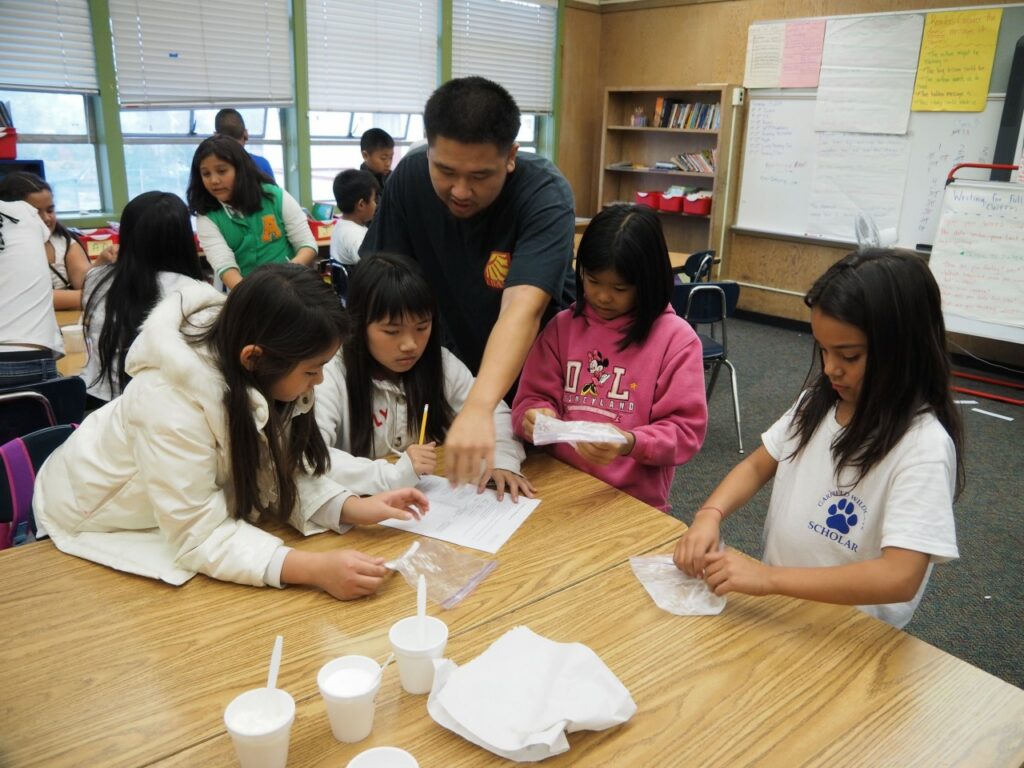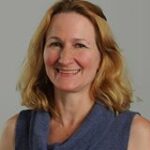 Liv Ames for EdSource
Liv Ames for EdSource Liv Ames for EdSource
Liv Ames for EdSourceMany teachers are not well-prepared to teach the new Next Generation Science Standards, according to new report released Tuesday.
Called “Science Teachers’ Learning: Enhancing Opportunities, Creating Supportive Contexts,” the report from the National Academies of Sciences, Engineering, and Medicine makes several recommendations to help educators transition to the standards, which emphasize deeper learning of broad scientific concepts instead of memorizing facts and stress the relationship between what is taught in the classroom and workplace practices of scientists and engineers.
California adopted the Next Generation Science Standards in 2013. They are expected to be fully implemented by 2018.
“An evolving understanding of how best to teach science, including the NGSS, represents a significant transition in the way science is currently taught in most classrooms and will require most science teachers to alter the way they teach,” the report concluded.
For the new science standards to make a difference in classrooms, teachers need training sessions that are more comprehensive than one or two days of professional development, the report said.
“The Next Generation Science Standards are a motivating factor for us to think differently about learning opportunities for both students and teachers,” said Suzanne Wilson, a professor of teacher education at the University of Connecticut and chairwoman of the committee that conducted the study, in a prepared statement.
The Committee on Strengthening Science Education, through a Teacher Learning Continuum, worked for about two years on the report, reviewing a number of studies related to science education and teacher training. It included five members from California. Paula Hooper, a former senior science educator in the Institute for Inquiry at the Exploratorium in San Francisco, was one of them.
To really transform the way science is taught in California and around the country, teachers need sustained professional development throughout their careers, which Hooper called “professional learning.” Although the state board has not yet approved a curriculum framework or instructional materials, Hooper said teachers should begin exploring new ways of teaching science now and share ideas together in professional learning communities. The standards, she said, encourage teachers to think about how science learning progresses from one grade level to the next.
For example, she said kindergartners learn about animal habitats. When students reach 4th grade, they can begin to make connections between animal habitats and the environment.
“Kids learn best when they are actively engaged in making sense of ideas,” she said. “It means you have to create environments where kids are playing with the phenomena themselves – whether you’re dropping a parachute, or looking at a rainbow, or playing with a simulation on a computer. That’s the kind of innovation I hope this report can really bring out in how people are thinking in California.”
The report, funded by the Merck Foundation, found that elementary teachers – especially those in low-income areas – lack the experience they need to make science come alive for students. That is because many teachers in such schools have less experience than their peers in more affluent schools and low-income schools have higher teacher turnover.
The new science standards have been adopted in 16 states. Like the Common Core State Standards in English language arts and mathematics, the new science standards stress college and career readiness skills, such as critical thinking, reasoning and problem-solving.
Similarly, the report outlined key scientific ideas and skills for teachers that will enable them to effectively implement the standards.
“Closing the gap between the vision of teaching science exemplified in the NGSS and current instruction in many schools will require creating a system of policies and practices that support individual and collective teachers’ needs, allowing them to deepen their own expertise, while challenging their students to learn, enjoy, and appreciate science,” Wilson said.
The report urged districts to provide professional learning opportunities to teachers both inside and outside of schools, allowing for collaboration and the development of teacher leaders or coaches. It also found that online programs and social networking could help teachers to connect around science themes and teaching strategies.
Professional learning can be enhanced through partnerships with teachers and their professional networks, higher education institutions, and cultural and community partners. For example, Hooper said the Exploratorium and Lawrence Hall of Science in the San Francisco Bay Area work with districts such as Oakland Unified to build teachers’ hands-on training in inquiry-based learning.
“Understanding how to make sense of problems and ideas requires thinking about not just the actual science knowledge, but also the skills that you need to have to process that knowledge,” Hooper said. “Students learn by actually doing things and coming back with their own thoughts about why things happen.”
Districts, the report said, should develop multi-year plans for professional learning linked to science goals for students.
“I think California districts are really ripe for the kinds of professional learning this report advocates,” Hooper said. “These are things that require teachers to become learning practitioners – to think about what it means for children to learn science this way – so children will make sense out of science ideas.”
To get more reports like this one, click here to sign up for EdSource’s no-cost daily email on latest developments in education.


Comments (3)
Comments Policy
We welcome your comments. All comments are moderated for civility, relevance and other considerations. Click here for EdSource's Comments Policy.
Jane Jackson 7 years ago7 years ago
Modeling Instruction is aligned with the Next Generation Science Standards. Modeling Instruction is used by high school science teachers nationwide. Some 50 to 60 Modeling Workshops are held each summer, and most are two or three weeks long (80 to 90 contact hours). Modeling Workshops thoroughly address most aspects of science teaching, including integration of teaching methods with course content. Workshops incorporate up-to-date results of physics and science education research, best curriculum materials, … Read More
Modeling Instruction is aligned with the Next Generation Science Standards. Modeling Instruction is used by high school science teachers nationwide. Some 50 to 60 Modeling Workshops are held each summer, and most are two or three weeks long (80 to 90 contact hours). Modeling Workshops thoroughly address most aspects of science teaching, including integration of teaching methods with course content. Workshops incorporate up-to-date results of physics and science education research, best curriculum materials, use of technology, and experience in collaborative learning and guidance. Workshops focus on all 8 science practices and cross-cutting concepts of the NRC Framework for K-12 Science Education (2012).
Participants are introduced to Modeling Instruction as a systematic approach to design of curriculum and instruction. The name Modeling Instruction expresses an emphasis on making and using conceptual models of phenomena in science as central to learning science. Math instruction is integrated seamlessly in each course by an emphasis on mathematical modeling.
In each workshop, content for an entire semester course is reorganized around models to increase its structural coherence. Participants are supplied with a complete set of course materials and work through activities alternately in roles of student or teacher. Teachers use computers as scientific tools to collect, organize, analyze, visualize, and model real data.
Modeling Workshops are listed at http://modelinginstruction.org/ under the “teachers” tab; and detailed descriptions are at http://www.phystec.org/pd/?set=Modeling . The American Modeling Teachers Association (AMTA) oversees them: the AMTA is a grassroots professional organization of, by, and for teachers who use Modeling Instruction.
Jessica Sawko 7 years ago7 years ago
Thank you so much for your coverage of this report. It highlights not only the need for an infusion of funding dedicated to science teacher professional learning, but also sustained funding for professional learning for teachers via the LCFF funds. California LEAs should fund professional learning for science teachers within the LCFF and LCAP. Professional learning should be offered by individuals qualified to provide professional learning in California Next Generation Science Standards (CA NGSS) and … Read More
Thank you so much for your coverage of this report. It highlights not only the need for an infusion of funding dedicated to science teacher professional learning, but also sustained funding for professional learning for teachers via the LCFF funds.
California LEAs should fund professional learning for science teachers within the LCFF and LCAP. Professional learning should be offered by individuals qualified to provide professional learning in California Next Generation Science Standards (CA NGSS) and must be focused on CA NGSS state science standards, not driven solely by instructional materials.
Teacher professional learning supports LCAP Priority 2, implementation of state adopted standards. Science teachers require quality standards-based professional learning that focuses on both content and effective pedagogy.
Replies
Theresa Harrington 7 years ago7 years ago
You’re welcome and thanks for sharing your views on the need for NGSS professional development!